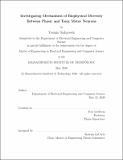Investigating mechanisms of biophysical diversity between phasic and tonic motor neurons
Author(s)
Siahpoosh, Yasmin(Yasmin H.)
Download1241187714-MIT.pdf (2.011Mb)
Other Contributors
Massachusetts Institute of Technology. Department of Electrical Engineering and Computer Science.
Advisor
Troy Littleton.
Terms of use
Metadata
Show full item recordAbstract
Neurons exhibit striking diversity in core neuronal properties (intrinsic biophysical and synaptic properties), which are the building blocks of brain function and computation. Despite the central role of these properties in brain function, the underlying molecular and biophysical mechanisms which generate this diversity remain incompletely understood. In the Drosophila larval motor system, phasic (1s) and tonic (1b) motor neurons (MNs) differ in their intrinsic biophysical properties, providing an ideal system to examine electrophysiological diversity across neuronal populations. To address this question, we combined in vivo whole-cell patch-clamp physiology with biophysical modeling. First, we characterized biophysical diversity between 1s and 1b MNs. To explore molecular mechanisms underlying such diversity, single-neuron PatchSeq RNA profiling experiments were carried out to correlate biophysical properties with differences in ion channel gene expression profiles. These experiments suggest that cyclic nucleotide- gated like (CNGL) ion channels are upregulated in 1b MNs several folds, which indicates that CNGL could be a candidate ion channel that might specify diversity in electrical properties . To test this hypothesis, we misoverexpress CNGL in 1s MNs so that we could investigate how this ion channel contributes to the diversity between them. We developed an analysis toolset in MATLAB that can be used to analyze whole-cell patch-clamp physiology data and obtain excitability properties. Using the Izhikevich model, we were able to quantify and predict the spiking properties of 1s and 1b MNs. Using a ball and stick model, we were able to reproduce the tonic firing pattern of 1b neurons and tested tonic firing patterns in different compartments of 1b neurons. Taken together, this thesis work laid the foundation to begin characterizing biophysical mechanisms of intrinsic diversity of Drosophila neurons by combining experimental data with modeling.
Description
Thesis: M. Eng., Massachusetts Institute of Technology, Department of Electrical Engineering and Computer Science, May, 2020 Cataloged from student-submitted PDF of thesis. Includes bibliographical references (pages 65-67).
Date issued
2020Department
Massachusetts Institute of Technology. Department of Electrical Engineering and Computer SciencePublisher
Massachusetts Institute of Technology
Keywords
Electrical Engineering and Computer Science.